How do I pretty-print a JSON file in Python?
15 Answers
Use the indent= parameter of json.dump() or json.dumps() to specify how many spaces to indent by:
>>> import json
>>> your_json = '["foo", {"bar": ["baz", null, 1.0, 2]}]'
>>> parsed = json.loads(your_json)
>>> print(json.dumps(parsed, indent=4))
[
"foo",
{
"bar": [
"baz",
null,
1.0,
2
]
}
]
To parse a file, use json.load():
with open('filename.txt', 'r') as handle:
parsed = json.load(handle)
- 14,854
- 11
- 100
- 103
- 289,723
- 53
- 439
- 496
-
230For simple pretty-printing this also works without explicit parsing: ``print json.dumps(your_json_string, indent=4)`` – Peterino Aug 04 '14 at 14:07
-
22Without the indent, you just get a single line of ugly text, which is why I came here. – krs013 Mar 16 '16 at 18:46
-
6This is similar to JavaScript `var str = JSON.stringify(obj, null, 4);` as discussed here http://stackoverflow.com/questions/4810841/how-can-i-pretty-print-json-using-javascript – Christophe Roussy May 31 '16 at 13:17
-
4@Peterino, it is not working without explicit parsing. It prints an escaped line – ACV Jul 02 '21 at 16:24
-
In JS tool prettier, it will not add 'line break' if the line width less than 80. I am looking for it. – Peterlits Zo Feb 22 '22 at 06:28
-
@PeterlitsZo did you find a way to use line wrap 80 for example not to make it look this silly? – PascalVKooten Sep 23 '22 at 08:23
-
@PascalVKooten Sorry but no. Do you think it will be good if I write a tool for it? I want to find a tool but I can't. – Peterlits Zo Sep 23 '22 at 14:41
-
Yea in my case I would really like a tool that would take a line length as option and then tries to fit more on one line. Kinda tricky though, because if you have `{"a": 1, "b": 2, "c"3}` maybe because it is so short it would still be better spread out over multiple lines? – PascalVKooten Sep 25 '22 at 00:06
You can do this on the command line:
python3 -m json.tool some.json
(as already mentioned in the commentaries to the question, thanks to @Kai Petzke for the python3 suggestion).
Actually python is not my favourite tool as far as json processing on the command line is concerned. For simple pretty printing is ok, but if you want to manipulate the json it can become overcomplicated. You'd soon need to write a separate script-file, you could end up with maps whose keys are u"some-key" (python unicode), which makes selecting fields more difficult and doesn't really go in the direction of pretty-printing.
You can also use jq:
jq . some.json
and you get colors as a bonus (and way easier extendability).
Addendum: There is some confusion in the comments about using jq to process large JSON files on the one hand, and having a very large jq program on the other. For pretty-printing a file consisting of a single large JSON entity, the practical limitation is RAM. For pretty-printing a 2GB file consisting of a single array of real-world data, the "maximum resident set size" required for pretty-printing was 5GB (whether using jq 1.5 or 1.6). Note also that jq can be used from within python after pip install jq.
- 6,043
- 3
- 27
- 39
-
5JQ is great but there is a max limit so its useless for large files. (i.e. blows up handling a 1.15mb file) https://github.com/stedolan/jq/issues/1041 – Chris McKee May 17 '16 at 08:35
-
13yeah, man, definitely, if you are writing jq filters with more than 10K lines of code I think you're trying something like going to mars with a bicycle. – Gismo Ranas May 17 '16 at 08:39
-
3lol :D @gismo-ranas The json.tool version piped to a file works really really well on large files; and is stupidly fast. I like JQ but formatting anything beyond a small payload (which you could do in most text editors) is beyond its reach :) Random addition: http://www.json-generator.com/ is a neat tool to make test data – Chris McKee May 17 '16 at 08:46
-
8
-
I don't think that Python's json lib will output the `u"some-key"` with the `u` – kbuilds Aug 31 '17 at 21:56
-
Plus with `curl -s` option you can hide sometime useless speed statistic. – ipeacocks Oct 19 '17 at 20:27
-
4Actually I strongly recommend using `python3 -m json.tool
OUT`, as this keeps the original order of the fields in JSON dicts. The python interpreter version 2 sorts the fields in alphabetically ascending order, which often is not, what you want. – Kai Petzke Jan 20 '19 at 17:00 -
2It's worth noting that `python -m json.tool` _does_ work, though, and is better than nothing. I know it's 2019 already, but there are still plenty of systems around that don't have `python3` installed! – Todd Owen Feb 13 '19 at 06:38
-
2Also, note that there is no need for the shell file redirections: `python3 -m json.tool in_file [out_file]` works directly (I updated the answer). – Eric O. Lebigot Apr 25 '20 at 09:31
-
3Unfortunately, python3 kills my non-ASCII characters, while jq handles them fine. Too bad python3 still cannot handle UTF-8 out of the box. – Holger Jakobs Nov 26 '20 at 15:50
After reading the data with the json standard library module, use the pprint standard library module to display the parsed data. Example:
import json
import pprint
json_data = None
with open('file_name.txt', 'r') as f:
data = f.read()
json_data = json.loads(data)
pprint.pprint(json_data)
The output will look like:
{'address': {'city': 'New York',
'postalCode': '10021-3100',
'state': 'NY',
'streetAddress': '21 2nd Street'},
'age': 27,
'children': [],
'firstName': 'John',
'isAlive': True,
'lastName': 'Smith'}
Note that this output is not valid JSON; while it shows the content of the Python data structure with nice formatting, it uses Python syntax to do so. In particular, strings are (usually) enclosed in single quotes, whereas JSON requires double quotes. To rewrite the data to a JSON file, use pprint.pformat:
pretty_print_json = pprint.pformat(json_data)
with open('file_name.json', 'w') as f:
f.write(pretty_print_json)
- 2,133
- 1
- 16
- 35
-
13Problem with this is that pprint will use single and double quotes interchangably, but json requires double quotes only, so your pprinted json may no longer parse as valid json. – drevicko Jun 29 '18 at 14:38
-
11Yes, but it's only to output a json file. Not to take the output and write it again in a file. – ikreb Jul 09 '18 at 14:01
-
2question specifically says to pretty print a json file, not a python representation of a json file – erik258 Nov 10 '21 at 16:37
-
-
3This solution has so many issues I can't even start. There's zero guarantee to be valid JSON, in fact, very often it won't be valid at all. Not only it will mix up the quotes all over, but also `pprint` will output many string representations that only make sense to Python. `None`, `datetime`, all sorts of objects, even when they have well defined ways to be JSON serializable. Replacing the single to double quotes only makes it worse, it will potentially not even be valid Python anymore, all you need is a double quote in any string. – Victor Schröder Sep 06 '22 at 17:04
-
3It's not my job as an editor to correct the technical details, but simply swapping single quotes for double quotes is **definitely not** sufficient to turn `pprint.pformat` output (just like `repr` output) into valid JSON, **even if** the data originally came from JSON. Trivial example: round-tripping the valid file contents `"\""` (representing, in JSON, a string containing a backslash) will produce `"""` (which is neither valid JSON nor a valid Python literal). Round-tripping the valid file contents `null` will produce a file containing `None`. – Karl Knechtel Jan 27 '23 at 05:23
Pygmentize is a powerful tool for coloring the output of terminal commands.
Here is an example of using it to add syntax highlighting to the json.tool output:
echo '{"foo": "bar"}' | python -m json.tool | pygmentize -l json
The result will look like:

In a previous Stack Overflow answer, I show in detail how to install and use pygmentize.
- 62,466
- 11
- 102
- 153
- 47,722
- 9
- 78
- 80
-
4In your example `-g` is not actually working ;) Since input comes from stdin, pygmentize is not able to make a good guess. You need to specify lexer explicitly: `echo '{"foo": "bar"}' | python -m json.tool | pygmentize -l json` – Denis The Menace Jan 29 '18 at 13:00
-
2@DenisTheMenace It used to work in 2015 when I created this example image. It doesn't seem to be working now on my system as well. – Shubham Chaudhary Jan 30 '18 at 09:19
Use this function and don't sweat having to remember if your JSON is a str or dict again - just look at the pretty print:
import json
def pp_json(json_thing, sort=True, indents=4):
if type(json_thing) is str:
print(json.dumps(json.loads(json_thing), sort_keys=sort, indent=indents))
else:
print(json.dumps(json_thing, sort_keys=sort, indent=indents))
return None
pp_json(your_json_string_or_dict)
- 3,500
- 3
- 31
- 65
-
This seems like just putting a nice interface on existing answers and not really engaging with the substance of the question. The key point here is the use of the `indent` keyword parameter, which is already well covered. Aside from that, it's valid for a JSON document to represent a single string. Determining which processing to use with the input should be the programmer's responsiblity, from applying logical reasoning - while Python is designed to allow this kind of flexibility, doing explicit type checking and coercion is generally discouraged. – Karl Knechtel Jan 27 '23 at 06:19
-
2
-
This is by far the best solution! jq is great for command line, but this is the best programmatic solution. Should be the top answer now. – Eamonn Kenny Jun 20 '23 at 10:11
Use pprint: https://docs.python.org/3.6/library/pprint.html
import pprint
pprint.pprint(json)
print() compared to pprint.pprint()
print(json)
{'feed': {'title': 'W3Schools Home Page', 'title_detail': {'type': 'text/plain', 'language': None, 'base': '', 'value': 'W3Schools Home Page'}, 'links': [{'rel': 'alternate', 'type': 'text/html', 'href': 'https://www.w3schools.com'}], 'link': 'https://www.w3schools.com', 'subtitle': 'Free web building tutorials', 'subtitle_detail': {'type': 'text/html', 'language': None, 'base': '', 'value': 'Free web building tutorials'}}, 'entries': [], 'bozo': 0, 'encoding': 'utf-8', 'version': 'rss20', 'namespaces': {}}
pprint.pprint(json)
{'bozo': 0,
'encoding': 'utf-8',
'entries': [],
'feed': {'link': 'https://www.w3schools.com',
'links': [{'href': 'https://www.w3schools.com',
'rel': 'alternate',
'type': 'text/html'}],
'subtitle': 'Free web building tutorials',
'subtitle_detail': {'base': '',
'language': None,
'type': 'text/html',
'value': 'Free web building tutorials'},
'title': 'W3Schools Home Page',
'title_detail': {'base': '',
'language': None,
'type': 'text/plain',
'value': 'W3Schools Home Page'}},
'namespaces': {},
'version': 'rss20'}
-
17
-
-
5@CharlieParker I expect they meant that knowing you have a valid JSON document is pretty useful. Sure, you can use the `json` module to work with the data and dictionary keys work the same with double- or single-quoted strings, but some tools, e.g. [Postman](https://getpostman.com) and [JSON Editor Online](https://jsoneditoronline.org/), both expect keys and values to be double-quoted (as per the JSON spec). In any case, [json.org](https://www.json.org/) specifies the use of double quotes, which `pprint` doesn't produce. E.g. `pprint.pprint({"name": "Jane"})` produces `{'name': 'Jane'}`. – Mar 07 '21 at 07:13
-
3@CharlieParker an example would be the `'language': None,` in the result above, which should be `"language": null`. Note the `null` and the double quotes. What you do is pretty-printing a Python object. – Daniel F Jul 28 '21 at 12:58
-
To be able to pretty print from the command line and be able to have control over the indentation etc. you can set up an alias similar to this:
alias jsonpp="python -c 'import sys, json; print json.dumps(json.load(sys.stdin), sort_keys=True, indent=2)'"
And then use the alias in one of these ways:
cat myfile.json | jsonpp
jsonpp < myfile.json
- 318
- 2
- 5
-
The `json` module provides `json.tool` explicitly to avoid the need for this kind of thing. – Karl Knechtel Jan 27 '23 at 06:26
def saveJson(date,fileToSave):
with open(fileToSave, 'w+') as fileToSave:
json.dump(date, fileToSave, ensure_ascii=True, indent=4, sort_keys=True)
It works to display or save it to a file.
- 26,547
- 23
- 88
- 127
- 129
- 1
- 5
You could try pprintjson.
Installation
$ pip3 install pprintjson
Usage
Pretty print JSON from a file using the pprintjson CLI.
$ pprintjson "./path/to/file.json"
Pretty print JSON from a stdin using the pprintjson CLI.
$ echo '{ "a": 1, "b": "string", "c": true }' | pprintjson
Pretty print JSON from a string using the pprintjson CLI.
$ pprintjson -c '{ "a": 1, "b": "string", "c": true }'
Pretty print JSON from a string with an indent of 1.
$ pprintjson -c '{ "a": 1, "b": "string", "c": true }' -i 1
Pretty print JSON from a string and save output to a file output.json.
$ pprintjson -c '{ "a": 1, "b": "string", "c": true }' -o ./output.json
Output
- 5,951
- 6
- 29
- 36
-
how is your soln different from `import pprint pprint.pprint(json)`? – Charlie Parker Feb 09 '21 at 23:06
-
@CharlieParker I think it produces a valid json document, as opposed to pprint which uses single-quotes instead of double-quotes – TheTechRobo the Nerd May 30 '21 at 23:43
Here's a simple example of pretty printing JSON to the console in a nice way in Python, without requiring the JSON to be on your computer as a local file:
import pprint
import json
from urllib.request import urlopen # (Only used to get this example)
# Getting a JSON example for this example
r = urlopen("https://mdn.github.io/fetch-examples/fetch-json/products.json")
text = r.read()
# To print it
pprint.pprint(json.loads(text))
- 467
- 5
- 4
-
2I get the following error message in Python 3: "TypeError: the JSON object must be str, not 'bytes'" – Mr. T Jan 23 '18 at 08:41
-
"without requiring the JSON to be on your computer as a local file: " - the question explicitly asked about a file, though. While it could potentially be useful to others to show how to grab the data from an Internet source, that is a **separate problem** pertaining to a **separate question**. (If someone had *asked* how to download a JSON file and pretty-print it, that would have been closed for lack of focus; it's blatantly two questions in one.) As it happens, that other question is already **very** well covered. – Karl Knechtel Jan 27 '23 at 06:35
TL;DR: many ways, also consider print(yaml.dump(j, sort_keys=False))
For most uses, indent should do it:
print(json.dumps(parsed, indent=2))
A Json structure is basically tree structure. While trying to find something fancier, I came across this nice paper depicting other forms of nice trees that might be interesting: https://blog.ouseful.info/2021/07/13/exploring-the-hierarchical-structure-of-dataframes-and-csv-data/.
It has some interactive trees and even comes with some code including this collapsing tree from so:

Other samples include using plotly Here is the code example from plotly:
import plotly.express as px
fig = px.treemap(
names = ["Eve","Cain", "Seth", "Enos", "Noam", "Abel", "Awan", "Enoch", "Azura"],
parents = ["", "Eve", "Eve", "Seth", "Seth", "Eve", "Eve", "Awan", "Eve"]
)
fig.update_traces(root_color="lightgrey")
fig.update_layout(margin = dict(t=50, l=25, r=25, b=25))
fig.show()
And using treelib. On that note, This github also provides nice visualizations. Here is one example using treelib:
#%pip install treelib
from treelib import Tree
country_tree = Tree()
# Create a root node
country_tree.create_node("Country", "countries")
# Group by country
for country, regions in wards_df.head(5).groupby(["CTRY17NM", "CTRY17CD"]):
# Generate a node for each country
country_tree.create_node(country[0], country[1], parent="countries")
# Group by region
for region, las in regions.groupby(["GOR10NM", "GOR10CD"]):
# Generate a node for each region
country_tree.create_node(region[0], region[1], parent=country[1])
# Group by local authority
for la, wards in las.groupby(['LAD17NM', 'LAD17CD']):
# Create a node for each local authority
country_tree.create_node(la[0], la[1], parent=region[1])
for ward, _ in wards.groupby(['WD17NM', 'WD17CD']):
# Create a leaf node for each ward
country_tree.create_node(ward[0], ward[1], parent=la[1])
# Output the hierarchical data
country_tree.show()
I have, based on this, created a function to convert json to a tree:
from treelib import Node, Tree, node
def create_node(tree, s, counter_byref, verbose, parent_id=None):
node_id = counter_byref[0]
if verbose:
print(f"tree.create_node({s}, {node_id}, parent={parent_id})")
tree.create_node(s, node_id, parent=parent_id)
counter_byref[0] += 1
return node_id
def to_compact_string(o):
if type(o) == dict:
if len(o)>1:
raise Exception()
k,v =next(iter(o.items()))
return f'{k}:{to_compact_string(v)}'
elif type(o) == list:
if len(o)>1:
raise Exception()
return f'[{to_compact_string(next(iter(o)))}]'
else:
return str(o)
def to_compact(tree, o, counter_byref, verbose, parent_id):
try:
s = to_compact_string(o)
if verbose:
print(f"# to_compact({o}) ==> [{s}]")
create_node(tree, s, counter_byref, verbose, parent_id=parent_id)
return True
except:
return False
def json_2_tree(o , parent_id=None, tree=None, counter_byref=[0], verbose=False, compact_single_dict=False, listsNodeSymbol='+'):
if tree is None:
tree = Tree()
parent_id = create_node(tree, '+', counter_byref, verbose)
if compact_single_dict and to_compact(tree, o, counter_byref, verbose, parent_id):
# no need to do more, inserted as a single node
pass
elif type(o) == dict:
for k,v in o.items():
if compact_single_dict and to_compact(tree, {k:v}, counter_byref, verbose, parent_id):
# no need to do more, inserted as a single node
continue
key_nd_id = create_node(tree, str(k), counter_byref, verbose, parent_id=parent_id)
if verbose:
print(f"# json_2_tree({v})")
json_2_tree(v , parent_id=key_nd_id, tree=tree, counter_byref=counter_byref, verbose=verbose, listsNodeSymbol=listsNodeSymbol, compact_single_dict=compact_single_dict)
elif type(o) == list:
if listsNodeSymbol is not None:
parent_id = create_node(tree, listsNodeSymbol, counter_byref, verbose, parent_id=parent_id)
for i in o:
if compact_single_dict and to_compact(tree, i, counter_byref, verbose, parent_id):
# no need to do more, inserted as a single node
continue
if verbose:
print(f"# json_2_tree({i})")
json_2_tree(i , parent_id=parent_id, tree=tree, counter_byref=counter_byref, verbose=verbose,listsNodeSymbol=listsNodeSymbol, compact_single_dict=compact_single_dict)
else: #node
create_node(tree, str(o), counter_byref, verbose, parent_id=parent_id)
return tree
Then for example:
import json
j = json.loads('{"2": 3, "4": [5, 6], "7": {"8": 9}}')
json_2_tree(j ,verbose=False,listsNodeSymbol='+' ).show()
gives:
+
├── 2
│ └── 3
├── 4
│ └── +
│ ├── 5
│ └── 6
└── 7
└── 8
└── 9
While
json_2_tree(j ,listsNodeSymbol=None, verbose=False ).show()
+
├── 2
│ └── 3
├── 4
│ ├── 5
│ └── 6
└── 7
└── 8
└── 9
And
json_2_tree(j ,compact_single_dict=True,listsNodeSymbol=None).show()
+
├── 2:3
├── 4
│ ├── 5
│ └── 6
└── 7:8:9
As you see, there are different trees one can make depending on how explicit vs. compact he wants to be. One of my favorites, and one of the most compact ones might be using yaml:
import yaml
j = json.loads('{"2": "3", "4": ["5", "6"], "7": {"8": "9"}}')
print(yaml.dump(j, sort_keys=False))
Gives the compact and unambiguous:
'2': '3'
'4':
- '5'
- '6'
'7':
'8': '9'
- 12,950
- 7
- 74
- 95
A very simple way is using rich. with this method you can also highlight the json
This method reads data from a json file called config.json
from rich import print_json
setup_type = open('config.json')
data = json.load(setup_type)
print_json(data=data)
- 105
- 1
- 7
I think that's better to parse the json before, to avoid errors:
def format_response(response):
try:
parsed = json.loads(response.text)
except JSONDecodeError:
return response.text
return json.dumps(parsed, ensure_ascii=True, indent=4)
- 1,449
- 3
- 13
- 15
I had a similar requirement to dump the contents of json file for logging, something quick and easy:
print(json.dumps(json.load(open(os.path.join('<myPath>', '<myjson>'), "r")), indent = 4 ))
if you use it often then put it in a function:
def pp_json_file(path, file):
print(json.dumps(json.load(open(os.path.join(path, file), "r")), indent = 4))
- 2,528
- 4
- 27
- 46
-
What does this really add over the top answers? A particular interface? – Karl Knechtel Jan 27 '23 at 06:32
It's far from perfect, but it does the job.
data = data.replace(',"',',\n"')
you can improve it, add indenting and so on, but if you just want to be able to read a cleaner json, this is the way to go.
-
-
Won't this screw up the file if you have a comma in a string? – TheTechRobo the Nerd Feb 11 '22 at 01:13
-
2This doesn't even remotely address the problem. Even in the best case, the output will look nothing like what OP presumably wanted. – Karl Knechtel Jan 27 '23 at 06:41




